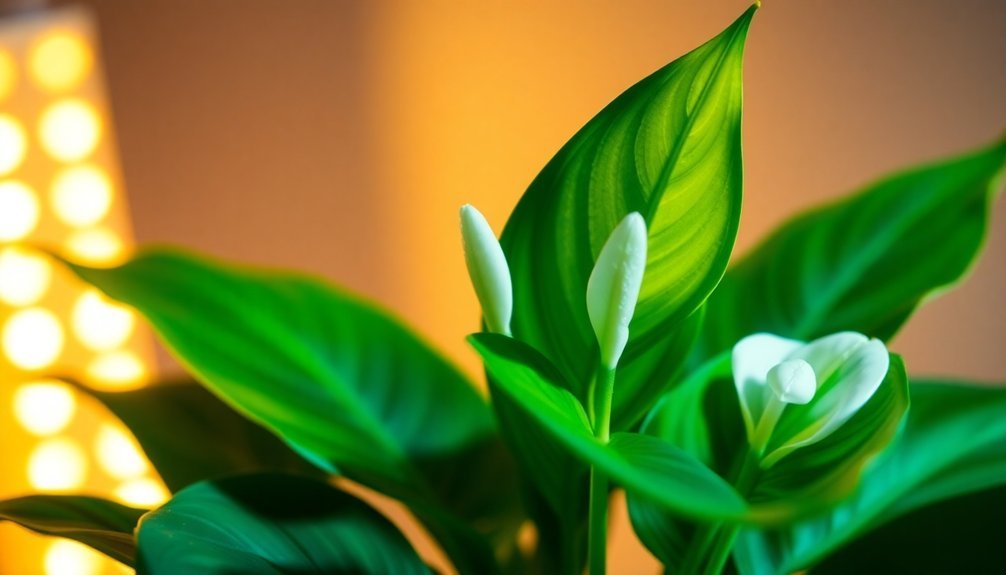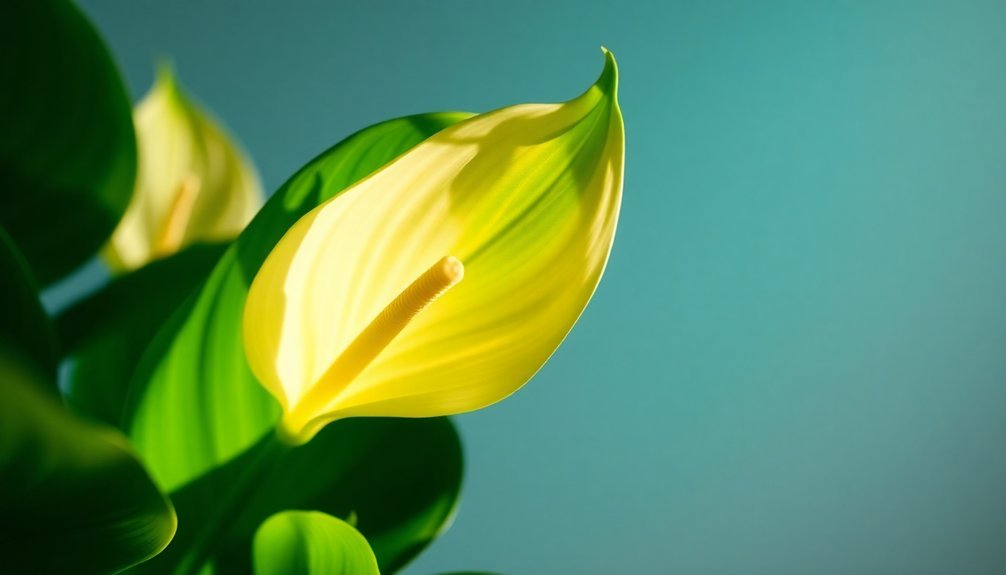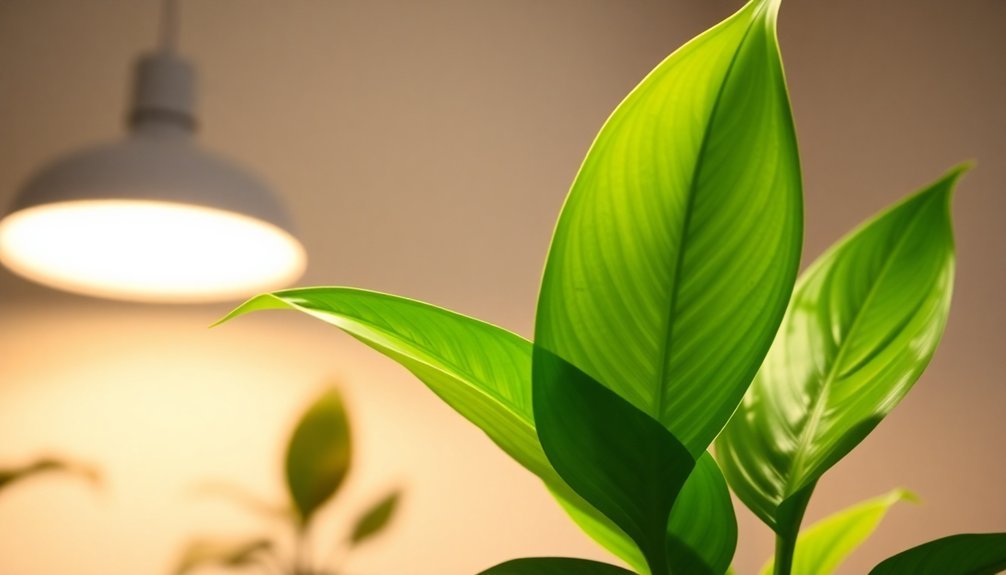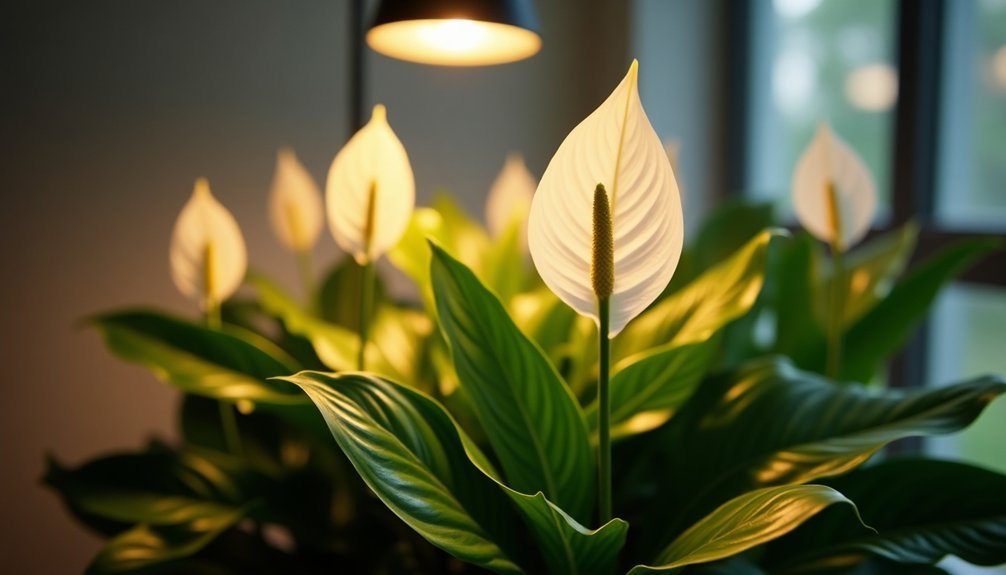Your peace lily needs LED grow lights that deliver PPFD levels between 80-400 µmol/m²/s, positioned 12-24 inches above the plant. Use full-spectrum lights operating in the 400-700 nm range, combining warm white LEDs with red and blue wavelengths. You'll want to provide 12-16 hours of daily light exposure and maintain a minimum intensity of 50 foot-candles (500 lux). Understanding the complete lighting requirements will help your peace lily truly flourish.
Understanding LED Light Intensity for Peace Lilies

While Peace Lilies can adapt to various lighting conditions, understanding LED light intensity is essential for their best growth.
You'll want to provide your Peace Lilies with LED lights that deliver a PPFD of 80-400 µmol/m²/s for maximum photosynthesis and blooming. The ideal daily light integral should range between 4-14 mol/m²/d to guarantee sufficient light exposure throughout the day.
For the best results, use full-spectrum LED lights that mimic indirect light conditions found in their natural habitat.
You'll need to maintain a light exposure period of 12-16 hours daily to support healthy growth.
Remember that while Peace Lilies need adequate light intensity for photosynthesis, they're sensitive to excessive heat, so position your LED lights at an appropriate distance to prevent leaf scorching.
Optimal Light Spectrum Selection
When selecting the ideal light spectrum for Peace Lilies, you'll need a combination of warm white LEDs and specific wavelengths that mirror their natural forest environment.
The best light spectrum should include both red and blue wavelengths, which are essential for foliage development and flowering.
You'll want to use full-spectrum LED lights that operate within the 400-700 nm range, providing your Peace Lilies with the complete light diet they need.
Make sure your artificial lighting delivers a PPFD of 80-400 µmol/m²/s for proper light intensity.
To maximize growth potential, set up your LEDs to provide consistent light for 12-16 hours daily.
Using a timer can help you maintain this schedule automatically, ensuring your plants receive the right amount of exposure without overexertion.
Daily Light Duration Requirements

To maximize your Peace Lily's growth potential, you'll need to provide 12-16 hours of consistent LED lighting daily, mimicking their natural light exposure patterns.
You'll notice ideal development when maintaining this photoperiod, which allows your plant to complete essential photosynthetic processes and energy storage.
Setting a timer for your LED grow lights guarantees your Peace Lily receives the right duration of light exposure while preventing stress from irregular lighting schedules.
Essential Lighting Time Windows
Since Peace Lilies evolved in tropical understory conditions, they need 12-16 hours of daily light exposure to thrive in your home.
To replicate their natural habitat, you'll want to provide consistent indirect light for optimal growth and blooming. If you're using LED grow lights, set them on timers to maintain this essential photoperiod.
You'll need to adjust your lighting schedule as seasonal changes affect natural daylight hours. During shorter winter days, supplement with artificial light to maintain the 12-16 hours Peace Lilies thrive on.
Watch for signs that your plant's getting adequate light, like proper leaf development and regular blooming cycles. Position your plant where it'll receive bright, indirect light during its active growing hours, and consider using light meters to guarantee ideal conditions throughout the year.
Photoperiod Impact On Growth
The daily light duration your Peace Lily receives directly affects its growth patterns and blooming potential. For best growth, your plant needs 12-16 hours of bright indirect light each day.
You'll want to maintain this photoperiod consistently to promote healthy foliage and abundant flowering.
If you're using artificial lighting, set up timers to guarantee your Peace Lilies get at least 10 hours of light exposure during the growing season.
When light requirements aren't met, you might notice leggy growth and reduced blooming. This happens because Peace Lilies naturally evolved to thrive under consistent light patterns in their native habitat.
Positioning LED Grow Lights Effectively
Properly positioning LED grow lights can make the difference between a thriving Peace Lily and one that struggles to survive. For effective positioning, place your LED lights 12-24 inches above your plant to achieve the right light intensity without risking leaf damage.
You'll want to use full-spectrum LED lights that deliver a PPFD of 80-400 µmol/m²/s, mimicking the natural dappled sunlight Peace Lilies love. For ideal growth, keep your lights on for 12-16 hours daily.
Don't forget to rotate your plant regularly to guarantee balanced growth and even light distribution across all leaves.
Monitor your Peace Lily's response to the lighting setup. If you notice signs of insufficient light or stress, adjust the height or duration accordingly. This attentive approach will help maintain healthy, vigorous growth.
Measuring Light Output and Coverage

Accurately measuring light output guarantees your Peace Lily receives ideal illumination for healthy growth. Use a light meter to monitor light intensity, ensuring your plant gets at least 50 foot-candles (500 lux) to meet its lighting needs.
To optimize coverage, check the PPFD levels, which should range between 80-400 µmol/m²/s. Your Peace Lily's DLI requirements fall between 4-14 mol/m²/d, so adjust your LED lights accordingly.
When measuring light output, consider the photoperiod – set your lights to run 12-16 hours daily using a timer.
Monitor the coverage area by measuring light intensity at different points around your plant. If you notice uneven distribution, adjust your LED lights' position while maintaining a safe distance of 12-24 inches to prevent leaf damage.
Seasonal LED Light Adjustments
You'll need to adjust your Peace Lily's LED lighting setup considerably between seasons, reducing intensity during winter months to 80-200 µmol/m²/s while maintaining 12-16 hours of daily exposure.
During summer, you should increase the PPFD to 200-400 µmol/m²/s to match the natural light conditions, but keep the lights positioned farther from the foliage to prevent leaf burn.
Using a timer and light meter will help you fine-tune these seasonal adjustments, ensuring your Peace Lily receives ideal light levels throughout the year.
Winter Light Intensity Reduction
When winter's shorter days and reduced sunlight arrive, your Peace Lily will need adjustments to its LED lighting schedule to maintain ideal growth.
You'll need to guarantee your plant receives at least 50 foot-candles of light intensity, which often requires supplemental LED lighting during these darker months.
Position your LED grow lights 12-24 inches above your Peace Lilies to provide bright, indirect light for 12-16 hours daily.
Use a light meter to monitor the intensity, aiming for at least 200 foot-candles to promote healthy growth and blooming.
Full-spectrum LEDs work best as they mimic natural sunlight across the light spectrum.
As seasonal changes occur, you'll want to adjust both the duration and intensity of your artificial lighting setup, being careful to avoid heat stress while maintaining ideal light levels.
Summer Brightness Level Boost
As summer approaches, Peace Lilies require a strategic boost in LED light intensity to match their natural growing conditions.
You'll need to provide PPFD levels between 80-400 µmol/m²/s for ideal growth and blooming. Set your full-spectrum LED lighting to deliver 12-16 hours of indirect light daily, focusing on warm white wavelengths that simulate gentle morning sunlight.
- Position your LED setup to prevent leaf burn by maintaining adequate distance from the plant.
- Adjust brightness gradually and monitor your Peace Lily's response to increased light exposure.
- Use sheer curtains or light diffusers if the summer brightness becomes too intense.
- Select LED lights with full-spectrum capabilities that emphasize warm white wavelengths.
Remember to regularly check your plant's health and adjust the light intensity as needed to maintain vibrant growth throughout the summer season.
Common LED Lighting Mistakes to Avoid

Despite their adaptability, Peace Lilies can suffer from improper LED lighting setups that compromise their health and growth.
You'll want to avoid high-intensity LED lights that generate excessive heat, as these can scorch your plant's leaves. Don't place lights too close – maintain 12-24 inches of distance to prevent light burn.
Make sure your LED light spectrum includes warm white tones that simulate natural, indirect light.
Keep your photoperiod consistent with 12-16 hours of daily exposure to support healthy blooming. When you're adjusting light intensity, do it gradually to help your Peace Lily acclimate to new conditions.
Remember that sudden changes in lighting can stress your plant and damage its foliage. By avoiding these common mistakes, you'll create an ideal environment for your Peace Lily to thrive.
Combining Natural and LED Light Sources
Creating an ideal lighting environment for your Peace Lily often involves strategically combining natural and LED light sources. Since these plants evolved in tropical rainforest conditions, they need 12-16 hours of bright, indirect light daily.
Position your plant near east or north-facing windows for natural light, and supplement with warm white spectrum LED grow lights to mimic their native habitat.
- Use a light meter to maintain minimum intensity of 50 foot-candles (500 lux) for peak health
- Choose LED grow lights that complement natural light during darker periods, especially in winter
- Introduce your Peace Lily gradually to the combined lighting setup to prevent stress
- Rotate your plant regularly to guarantee even exposure to both natural and artificial light sources
Remember to monitor your plant's response to help fine-tune the perfect balance between natural and LED lighting conditions.
Frequently Asked Questions
What Type of Light Does a Peace Lily Need?
You'll need bright, indirect light for your peace lily, ideally near east or north-facing windows. You can also use warm white LED grow lights for 12-16 hours daily, maintaining 80-400 µmol/m²/s intensity.
Can Peace Lily Survive in Artificial Light?
Yes, your peace lily can survive and thrive in artificial light. You'll get the best results with LED or fluorescent lights providing bright, indirect illumination for 12-16 hours daily, mimicking natural light conditions.
How Do I Know if My Peace Lily Is Getting Too Much Light?
You'll notice yellowing leaves, brown crispy spots, and drooping foliage if your peace lily's getting too much light. Watch for soil that dries quickly after watering – these are clear signs to move it somewhere shadier.
Do Peace Lilies Like Direct or Indirect Light?
Your peace lily prefers indirect light. You'll want to avoid direct sunlight, which can scorch its leaves. Place it near east or north-facing windows where it'll receive bright, filtered light throughout the day.
In Summary
You'll get the best results with LED grow lights that provide 2000-3000 lumens or PAR values between 100-200 for your peace lilies. Position the lights 12-24 inches above the plants and run them 12-14 hours daily. Remember to adjust brightness seasonally and combine with natural light when possible. If your leaves yellow or brown, you're likely providing too much light intensity, so dial it back gradually.





Leave a Reply